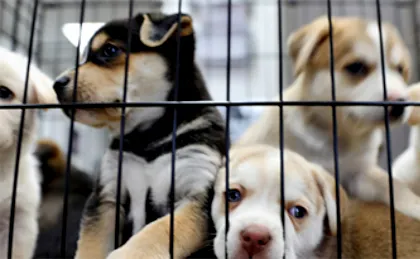Should you spay your female Sheltie? Here are the pros and cons of spaying and why this is an issue no animal lover should ignore.
Spaying your dog means to surgically remove the reproductive organs: the ovaries, uterine horns, and the body of the uterus. It prevents female heat cycles and pregnancy, and reduces the risk of several reproductive diseases. But what are the downsides? Isn't spaying cruel? Let's take a look at the details.

Should you spay your Shetland Sheepdog?
Should I Spay My Sheltie?
It's normal to feel weird about desexing your dog. We don't do it to humans, so how can we justify spaying a beloved canine member of the family?
It's important to recognize these are pets, not people. We often treat dogs as our children, but our dogs will never lead independent lives, get married, and raise their own families. A dog's purpose in life is companionship. In return, we take care of their needs and make the best decisions for them. Desexing is one of those decisions, and there are several factors to consider.
The Pros of Spaying Dogs
1. Prevent Estrus
Shelties enter their first heat cycle around 8-10 months old, which repeats every 6 months during her reproductive years. During this time, females produce a bloody discharge for about three weeks and release powerful airborne pheromones that attract unneutered males across miles. It’s essential that you keep unspayed females secure and indoors during estrus, and only exercise her in remote areas lest her urine and vaginal discharge blaze a scent trail back to your home.
2. Prevent Pregnancy
Spaying means to surgically remove the reproductive organs: the ovaries, uterine horns, and body of the uterus. It prevents any chance of pregnancy and labour which carry inherent health risks to the mother. Pregnancy is also expensive: vet visits for the mother, plus vet checks and vaccinations for the 6-8 puppies cost on average more than $2,000. Furthermore, after raising a litter for two months, it may be hard to find new homes for the puppies. If abandoned to rescue shelters they may end up being some of the three million unwanted dogs euthanized each year.
3. Reduce Cancer
Timely spaying reduces hormone levels which contribute to the development of uterine, mammary, and ovarian cancers later in life. For instance, spaying before the first heat (by 8 months) reduces her risk of mammary cancer to 0.5%, which rises 8% if you spay after the first heat, and 26% after the second heat. Spay by 8 months for maximum protection.
4. Reduce Pyometra
Spaying before the first heat cycle prevents pyometra, an infection in the uterus that causes the uterine horns to swell. If untreated, the uterus eventually ruptures, spilling bacterial fluid into the abdomen which is life-threatening. Treatment involves a complete ovariohysterectomy costing up to $1,000 and can leave females with increased lifelong strain on the kidneys and heart.
5. Save Money
The cost of spaying a dog at a Humane Society or a low-cost clinic is between $50 and $500 depending on the size of your dog and where you live. In the long run, spaying is much cheaper than surgery to treat the cancers and pyometra seen more often in unspayed dogs.
6. Improve Coat
Female hormones inhibit the growth of hair and fur during heat cycles and whelping, causing it to thin out and even expose the skin. It can take 2-4 months for the coat to return to normal or near normal.
The Cons of Spaying a Dog
1. Risk of Anesthesia
Spaying takes place under general anesthesia, which carries risks of developing blood clots, arrhythmia, and respiratory depression while dogs are under. The risk of a dog dying under general anaesthesia is 0.05% and blood work done in advance can reduce the risk further. Herding breeds in particular are more likely to suffer an allergic reaction to pre-anesthetic drugs. This is due to a mutation in the MDR1 mutation in 16% of Shelties which affects the accumulation of certain drugs in the body. Vets should adjust their drug protocol in Shelties to be safe.
2. Risk of Aggression
For decades vets have recommended spaying at 5-8 months, but due to overpopulation, some animal shelters now spay dogs as young as 6 weeks. Early spaying may increase aggression in females, as it prevents the production of progesterone which uplifts serotonin levels.
3. Spay Incontinence
Larger breeds can develop spay incontinence on average 3 years after the surgery, causing leaking from the bladder. It’s caused by low estrogen levels weakening the muscle tone around the urethra. However, spay incontinence is less common in small dogs, at a rate of around 5% in dogs under 44lbs (20kg), and can be treated with medication.
Final Thoughts
As you can see, there are a few factors to consider before you decide if and when to spay your Sheltie. The issue that stands out from the crowd is the problem of dog overpopulation. Sadly, there is a lot of ignorance on the subject, so it means a lot when dog owners like yourself take the time to consider the issue.
Note that in the US many professional Shetland Sheepdog breeders require you to sign a spay agreement before you buy a puppy from them. This is to ensure that only the healthiest and well-adjusted Shelties are bred to propagate the breed standard. Without their care and attention, there would be no Sheltie breed at all.
It also ensures that pet owners don't add to the problem of unplanned breeding and dog overpopulation at large. So if you want a purebred dog as a pet, you will likely be obligated to spay your Sheltie anyway. This also goes for adopted Shelties: many rescue shelters spay and neuter dogs as a matter of principle before re-homing them.









